Everyone loves growing a sunflower, Right? Well, if you love full-sized sunflowers. You’ll certainly love Dwarf Sunflower.
In this growers guide for Dwarf Sunflowers, we’ll tell you all there is to know about these amazing plants which are very popular with children and gardeners of all ages.
Personally, one of my favorite flowers to grow.
Read on for more information and see if you’d like to give them a try.
What are dwarf sunflowers?
Dwarf sunflowers are simply miniature versions of the normal, tall sunflower, Helianthus annuus.
Standard sunflowers can reach heights of over 8 feet (2.5 meters), but the dwarf sunflower barely grows beyond knee height with most varieties achieving a maximum height of only 3 feet (90 centimeters).
A giant daisy
Helianthus annuus belongs to the daisy family of flowers with the Latin name derived from the Greek words “helios” and “anthos”, literally “sun” and “flower”.
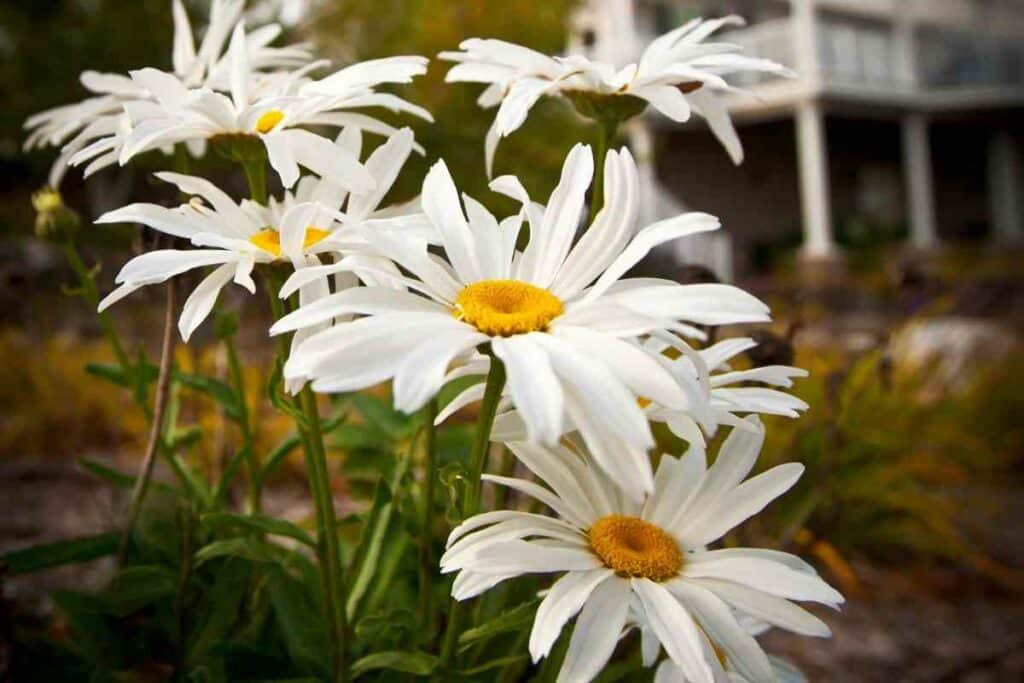
Though sunflowers originate from the southeastern US, people cultivate these beautiful flowers across the world.
Even Better – They are not only great-looking flowers, their prolific seed production has made them a valuable oilseed crop in many countries.
Pick and mix dwarf varieties
The dwarf varieties of sunflower have arisen through extensive breeding with many hybrids to enjoy.
Dwarf sunflowers are often small versions of popular standard varieties, with a great variety of color combinations to choose from.
Dwarf sunflowers only turn up once per year
Dwarf sunflowers are mostly annuals, with only a few varieties returning a second year.
This means that once the show’s over, these beauties are not returning.
Sow again next year, or let seed from mature sunflowers you’ve grown dry and drop into the soil.
Why grow dwarf sunflowers?
Dwarf sunflowers are beautiful and easy to grow!
If new further reasons than that, here are some great reasons to plant dwarf sunflowers in your garden.
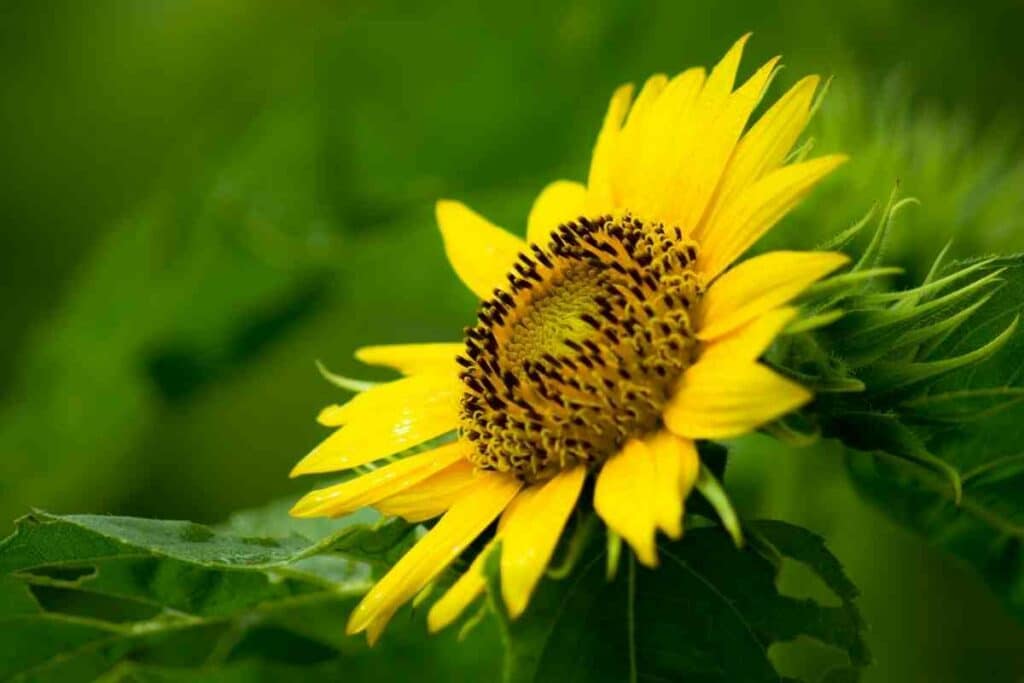
Dwarf sunflowers are great for kids
The big smiley face flower heads of sunflowers capture the imagination of young children, who love to see them grow to a height where they can appreciate them.
Dwarf sunflowers a perfect for containers and borders
A border of eight-foot-tall sunflowers would look ridiculous.
The lower height, branching, and double heads of dwarf sunflower varieties add interest to borders and the low height can look bushy and shrub-like in the right container.
Great for cutting
Horticulturists have developed many dwarf sunflower varieties for cutting with lovely stems and few leaves.
The shorter height of these flowers makes cutting easy.
10 great dwarf sunflower varieties to enjoy in your home or garden
These little sunflowers are incredibly moreish plants to grow.
If you are looking for dwarf sunflower seeds, you’ll find that you have hundreds of cute varieties to choose from.
Here are some of the most popular dwarf sunflower varieties.
1. Little Becka sunflowers
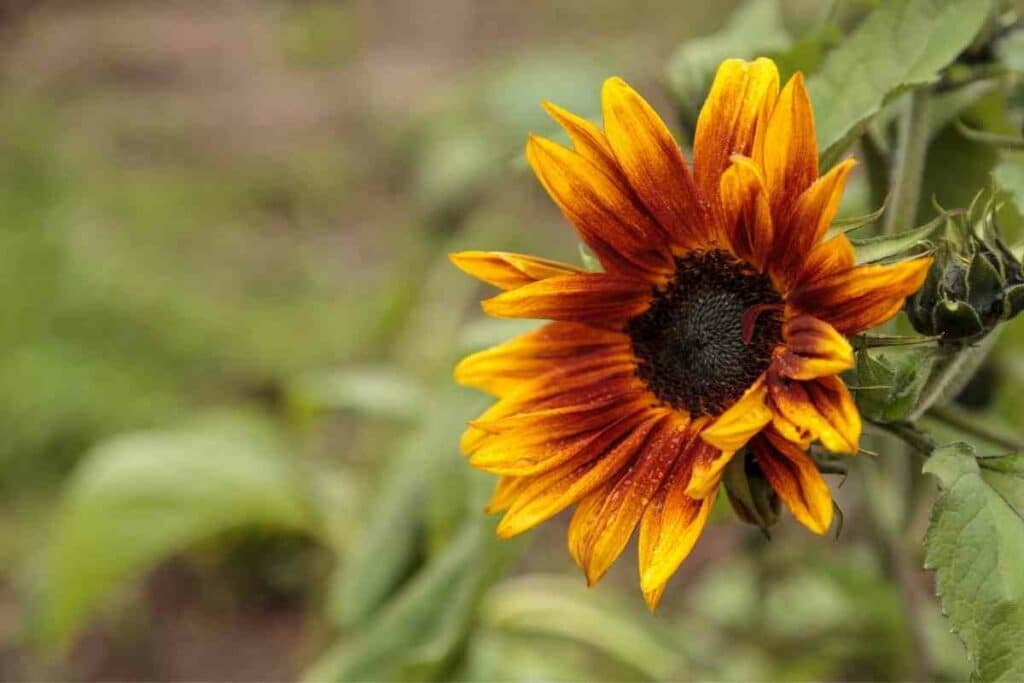
This sweet sunflower is crazy productive with stunning copper-red flowers with a double halo and dark heart.
This striking dwarf sunflower variety is extremely sophisticated and will look amazing cut in your home or outdoors in a mass display. Expect Little Becka to grow only three feet in height.
2. Florenza sunflowers
This rare variety is known for its red-orange and yellow combination and delicious chocolate scent.
Keep In Mind – They have strong, firm stems and few leaves, making them great for cutting. Florenza flowers grow to a height of two to three feet.
3. Elf sunflowers
This is the world’s smallest sunflower variety and grows to just over a foot tall.
This sweet variety grows in pleasing clusters that will delight the little gardeners of your household.
Elf is great for attracting pollinators and the classic yellow flowers last a long time.
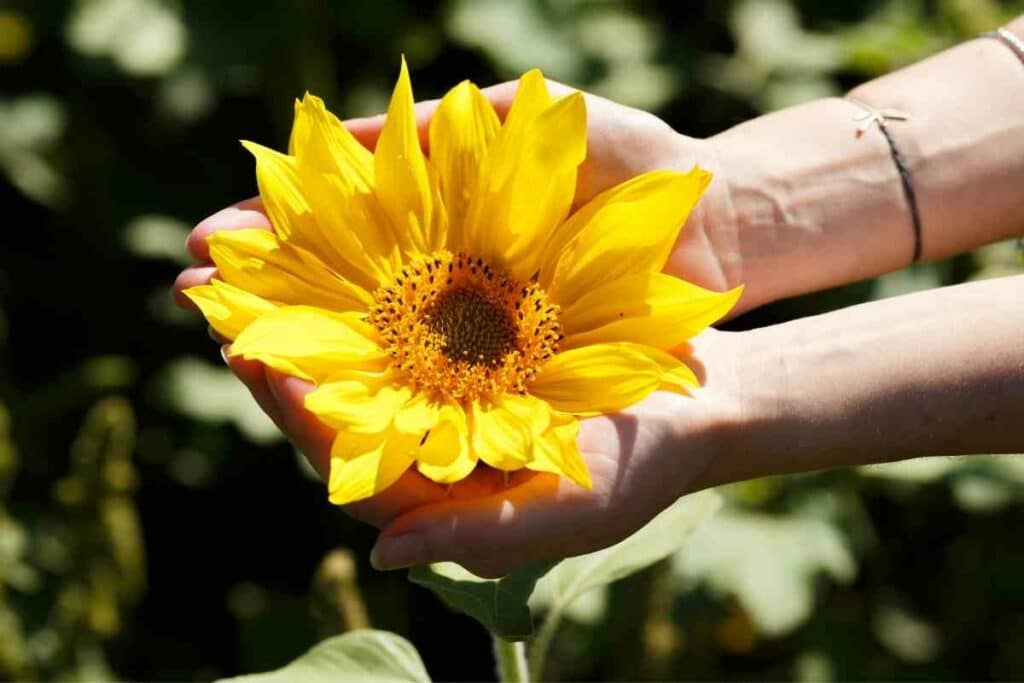
4. Double Dandy sunflowers
This hybrid variety of dwarf sunflower is great to grow if you have hay fever as the flowers it produces are pollen-free flowers.
This sunflower is anything but traditional with gorgeous double blooms that have a deep red coloring. Double Dandies only reach a maximum height of two feet.
5. Sunbright (F1) sunflowers
Sunbright is a hybrid variety that is also pollen-free.
This cheery dwarf sunflower produces golden yellow sunflowers of 6 inches (15 centimeters) in diameter that look beautiful in a bouquet.
Sunbright grows best in cooler weather and achieves a maximum height of 3 feet.
6. Teddy Bear (HA) sunflowers
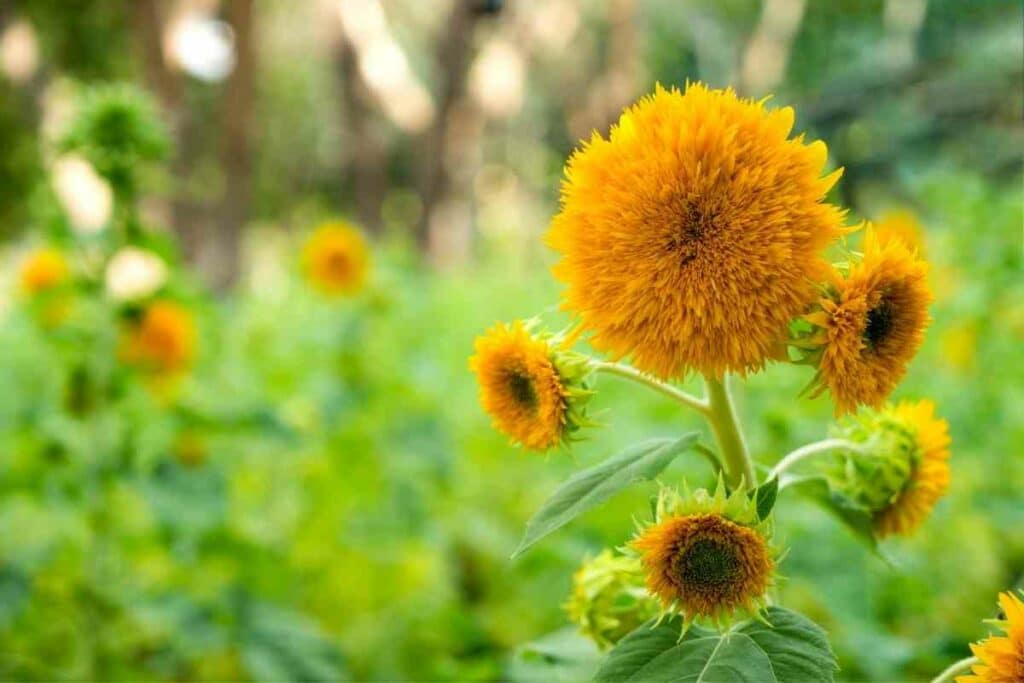
These fluffy double flowers look more like dahlias than traditional sunflowers!
You’ll adore the cute and cuddly-looking blooms which make a statement on borders or in a large pot on the patio.
It only grows 18 inches (45 centimeters) high, with a spread of up to 1 foot (30cm).
7. Pacino Gold (A)
This hardy annual dwarf sunflower is easy to grow and care for.

Treat it to a sunny spot on your patio, or plant sparingly in mixed borders.
It usually grows to a height of 2 feet and is very productive with lots of bright yellow heads on each plant.
8. Topolino sunflowers
Sunflower Topolino is a cheerful branching dwarf sunflower variety that produces bold yellow flowers with a dark center, on dwarf plants with a branching habit.
It is a great pick for growing with young children who will get a good look at the flower heads as it grows just over a foot high (30 to 40 centimeters).
9. Gaillardia sunflowers
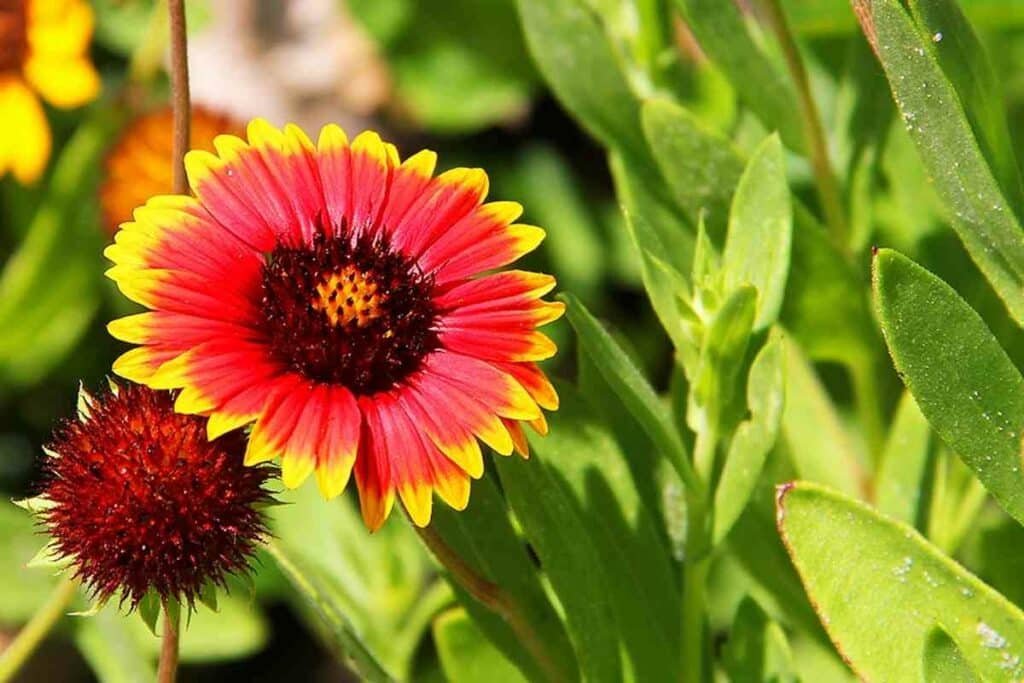
This cute annual produces delightful almost daisy-like flowers.
The bright two-toned blooms are prolific and give rise to the name blanket flower, or Indian blanket.
It’s an easy-going pick that gives you blooms throughout the summer and can for s second year. One for your border!
10. Mezzulah sunflowers
These dwarf pollen-free hybrids have classic golden-yellow petals with a dark center.
They grow to a height of two to three feet with strong stems that will support the flowers when they are cut.
How to grow dwarf sunflowers
Growing dwarf sunflowers is a satisfying family garden project because it’s so easy to do!
Once sown, dwarf sunflowers grow over three months (95 days).
Once you choose a variety of dwarf sunflower seeds, it’s simply a matter of sowing and growing.
Sowing dwarf sunflower seeds
Hold back from snacking on your dwarf sunflower seeds (which are edible) and sow them directly into your garden soil after the last frost.
Make a half-inch deep hole with a dibber and sow three to four seeds. Cover with soil and lightly water in.
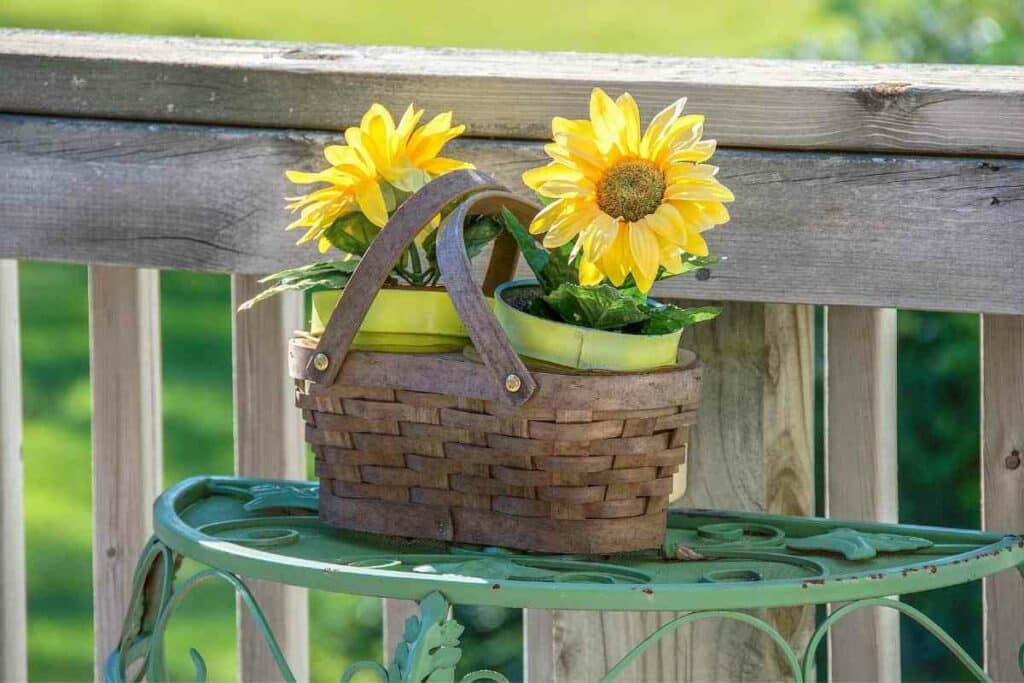
Alternatively, you can sow them in a pot of all-purpose compost to keep the birds from tucking in.
If you are going to grow in a pot, sow one seed per 6-inch (15 cm) diameter pot or up to 4 seeds in a gallon-volume pot.
If you intend to transplant the seedlings, they should be sown a month before planting out.
Remember – Dwarf sunflower seeds germinate in 7 to 14 days if kept at temperatures between 70 and 75°F (21 and 24°C).
Transplanting dwarf sunflower seeds
Dwarf sunflowers hate root disturbance, so give them time before thinning them and transplanting them into your yard.
Ideally, wait for three to four true leaves to appear, before moving them to your yard.
Container growing dwarf sunflowers
Dwarf sunflowers could be the ideal occupants of a beautiful spot on your patio.
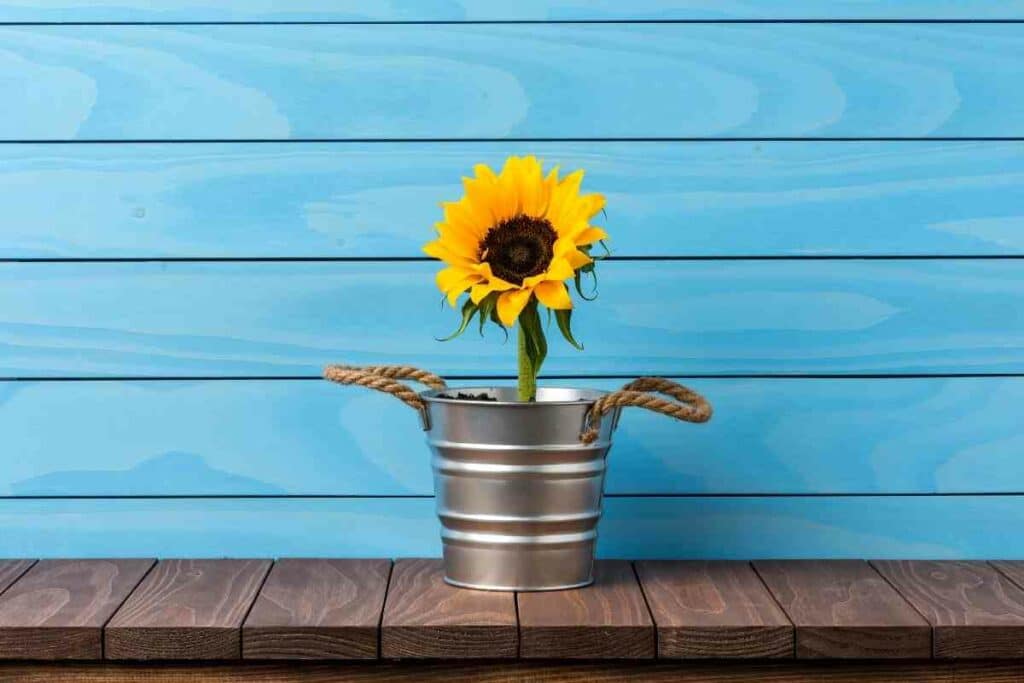
The growing method is simple, just sow onto the compost, ensure good drainage, and place your growing sunflowers in a sunny spot.
Container-grown dwarf sunflowers grow smaller than sunflowers grown in open ground.
Growing conditions for dwarf sunflower
The name of these flowers gives you a big hint that they need a lot of sun, six hours daily in a sunny spot is ideal.
Heads Up! Soil should be well-draining. If you are looking for a mass of sunny dwarf sunflowers, ensure they are spaced about a foot apart so that they do not become stunted.
Growing on dwarf sunflowers
Outside, your growing plants require a daytime temperature of 70 to 80°F (21 to 27°C) and not lower than 50 to 60°F (10 to 16°C) at night.
Temperature affects the growth of these sunflowers with warmer weather inducing stretching of the main stem and colder weather keeping the sunflower dwarf and compact.
Dwarf sunflower pests and diseases
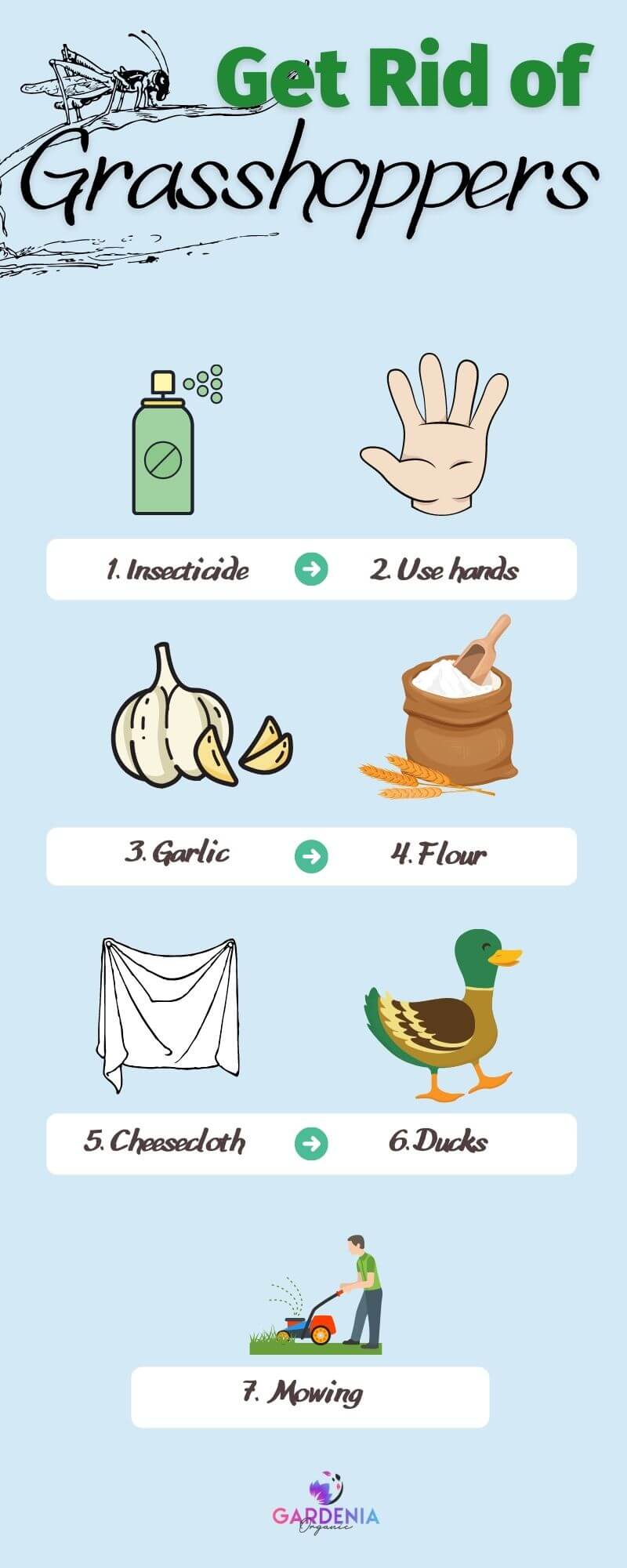
Keep the growth of your dwarf sunflowers on track by staying vigilant for common pests and diseases that will target sunflowers.
Find out how to get rid of grasshoppers – Do Grasshoppers Bite?
Dwarf sunflower pests
Here are the common dwarf sunflower pests to look out for in your yard.
- Sunflower borers: These insects and their larvae bore into sunflower stems and feed on their sap. The damage can quickly overwhelm sunflowers, especially if there are large numbers of borers.
- Sunflower beetles: Sunflower beetles target the leaves of the sunflowers. If your plants are mature, the damage will be unsightly but the overall damage is minimal. For younger plants, damage to too much of the foliage can stunt the plant’s growth.
- Sunflower cutworms: Cutworms also damage sunflower foliage causing holes, notching, and wilting.
- Sunflower Moths: The sunflower moth is a pernicious sunflower pest. Its whole lifecycle will destroy sunflowers, with the moth eggs laid within the sunflower hatching to produce larvae that feed on the developing flower head, destroying them.
- Grasshoppers: Grasshoppers are also partial to your dwarf sunflower foliage. If you have large numbers of grasshoppers descending on your sunflowers, they could defoliate everything!
You can dodge certain sunflower pests by dodging the early planting times and opting for a summer planting which may bypass the peak activity of certain pests.
Avoid the use of conventional pesticides if you are intending to harvest sunflower seeds for eating.
You can also spray growing plants down with a variety of solutions including:
- Ammonia
- Baking soda
- Dish soap
- Vegetable oil
Dwarf sunflower diseases
Most sunflower diseases affect other plants and are because of high humidity or dampness.

Here are the key diseases that affect sunflowers.
- Leaf spot: this common plant ailment is down to fungus in a damp atmosphere clinging to the underside of the lower leaves of the sunflower. Spotted leaves respond to fungicide spays or using a sulfur or copper octanoate spray.
- Powdery mildew: a variety of fungi that leave a white powdery coating on the leaf cause this condition. Remove affected leaves or treat with the sprays shared above.
- Sclerotinia stem rot: this is another fungal condition that takes out the stem of the sunflower. Fungus rots the sunflower from the inside out with wilting and a progressive rot that harms the root and the head.
- Verticillium wilt: soil-borne fungi enter the plant through its roots causing sudden wilting and yellowing of leaves.
Cutting sunflowers
Dwarf sunflowers are great for cutting and making a bold and beautiful floral display.
Once your sunflowers develop flower heads you can cut the stems to a suitable length at a 45° angle.
This prevents the stem from being flat on the bottom of your vase and rotting. While you harvest, place your sunflowers in a bucket of clean water.
Prep your stems by removing all foliage but the leaves closest to the flower head.
Here are some helpful tips for cutting sunflowers for your vase.
Saving sunflower seeds
Sunflower seeds are a delicious treat for you and local wildlife.
Dwarf sunflowers produce edible seeds, just like the larger variety.
Once the sunflower bloom has faded, remove the seeds from the flower head.
You can eat them raw, or oven-roast them. Remember to save a few in a clean dry airtight container for next year!
Rounding up
Dwarf sunflowers are a delight to grow with something for everyone and an edible treat at the end of your hard work.
With so many varieties, it’s hard to have a favorite. They’re a great reason to get growing with the family!
